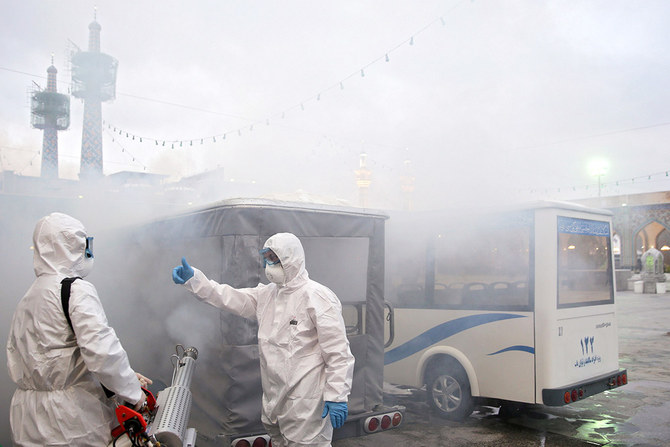JEDDAH: An Iranian member of parliament died on Saturday after becoming infected with coronavirus, one of nine new fatalities.
The death toll in Iran is now 43, the highest outside China, and the total number infected has risen to 593.
Several, including a vice president, the deputy health minister and five MPs, have tested positive for the virus as the outbreak forced the regime to close the parliament and impose internal travel bans.
Tehran has also ordered the shutting of schools until Tuesday and extended the closure of universities and a ban on concerts and sports events for a week. Authorities have also banned visits to hospitals and nursing homes.
Opinion
This section contains relevant reference points, placed in (Opinion field)
Iran is at the center of the spread of the coronavirus through the Middle East. Qatar and Oman both reported their first cases on Saturday, both linked to travel from Iran. The UAE suspended nursery classes and school trips.
Saudi Arabia is now the only Gulf Arab state not to have reported any cases of the coronavirus, but pharmacies in the Kingdom are nevertheless struggling to meet the demand for face masks.
“Despite assurances by the Ministry of Health, people have been demanding face masks, and I’m seeing more people wearing them in public,” pharmacist Adel Abdul Shakoor told Arab News. “We are out of masks now and usually we have full shelves.”
The Ministry of Health said all measures had been taken to protect the Kingdom against the virus and confirmed that there have been “no known cases” of infection.
ALSO READ:
LIVE: Middle East renews travel warnings as cases of coronavirus increase in Iran
Lebanon shuts schools after fourth coronavirus case
Virus spreading worldwide as more countries report first cases
South Korean ‘cult’ blamed for spike in coronavirus cases
Since December the virus has infected more than 85,919 people and killed 2,941, mostly in China.
The first death from the virus in the US was confirmed on Saturday night in Washington state, prompting the governor to declare a state of emergency on Saturday.
Gov. Jay Inslee directed state agencies to use “all resources necessary” to prepare for and respond to the outbreak. The declaration also allows the use of the Washington National Guard, if necessary.
Dr. Jeffrey Duchin, a Seattle and King county health official who works with the US Centers for Disease Control and Prevention, said the person who died was a man in his 50s.
President Donald Trump described the person as having a high medical risk. He said healthy Americans should be able to recover if they contract the new virus.
Health officials in California, Oregon and Washington state worried about the novel coronavirus spreading through West Coast communities after confirming at least three patients were infected by unknown means. The patients had not visited an area where there was an outbreak, nor apparently been in contact with anyone who had.
(With AP)




























